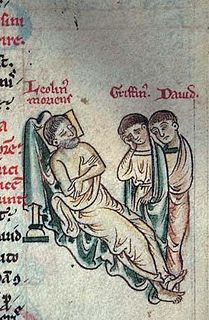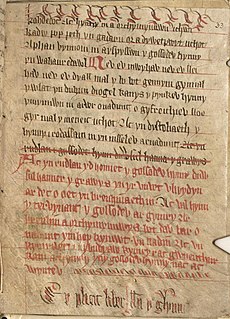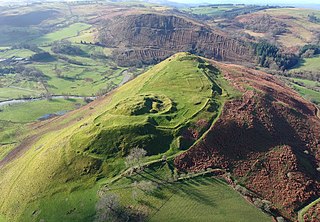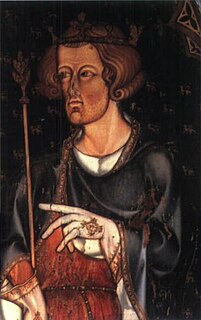Related Research Articles

Rhys ap Gruffydd or ap Gruffudd was the ruler of the kingdom of Deheubarth in south Wales from 1155 to 1197. Today, he is commonly known as The Lord Rhys, in Welsh Yr Arglwydd Rhys, although this title may have not been used in his lifetime. He usually used the title "Proprietary Prince of Deheubarth" or "Prince of South Wales", but two documents have been discovered in which he uses the title "Prince of Wales" or "Prince of the Welsh". Rhys was one of the most successful and powerful Welsh princes, and, after the death of Owain Gwynedd of Gwynedd in 1170, the dominant power in Wales.

The history of Wales begins with the arrival of human beings in the region thousands of years ago. Neanderthals lived in what is now Wales, or Cymru in the Welsh language, at least 230,000 years ago, while Homo sapiens arrived by about 31,000 BC. However, continuous habitation by modern humans dates from the period after the end of the last ice age around 9000 BC, and Wales has many remains from the Mesolithic, Neolithic, and Bronze Age. During the Iron Age the region, like all of Britain south of the Firth of Forth, was dominated by the Celtic Britons and the Brittonic language. The Romans, who began their conquest of Britain in AD 43, first campaigned in what is now northeast Wales in 48 against the Deceangli, and gained total control of the region with their defeat of the Ordovices in 79. The Romans departed from Britain in the 5th century, opening the door for the Anglo-Saxon invasion. Thereafter Brittonic language and culture began to splinter, and several distinct groups formed. The Welsh people were the largest of these groups, and are generally discussed independently of the other surviving Brittonic-speaking peoples after the 11th century.

Llywelyn the Great, full name Llywelyn ap Iorwerth), was a King of Gwynedd in north Wales and eventually ruler of all Wales. By a combination of war and diplomacy he dominated Wales for 45 years.
The Welsh Marches is an imprecisely defined area along the border between England and Wales in the United Kingdom. The precise meaning of the term has varied at different periods.
In Middle Ages in England and Scotland the Chief Justiciar was roughly equivalent to a modern Prime Minister of the United Kingdom as the monarch's chief minister. Similar positions existed in continental Europe, particularly in Norman Italy and in the Carolingian Empire. The term is the English form of the medieval Latin justiciarius or justitiarius.

The Statute of Rhuddlan, also known as the Statutes of Wales or as the Statute of Wales, provided the constitutional basis for the government of the Principality of Wales from 1284 until 1536. The Statute introduced English common law to Wales, but also permitted the continuance of Welsh legal practices within the Principality. The Statute was superseded by the Laws in Wales Acts 1535 and 1542 when Henry VIII made Wales unequivocally part of the "realm of England".

Rhys ap Tewdwr was a king of Deheubarth in Wales and member of the Dinefwr dynasty, a branch descended from Rhodri the Great. He was born in the area which is now Carmarthenshire and died at the battle of Brecon in April 1093.

The Principality of Wales existed between 1216 and 1536, encompassing two-thirds of modern Wales during its height between 1267 and 1277. For most of its history it was ’annexed and united’ to the English Crown except for its earliest few decades. However, for a few generations, specifically the period from its foundation in 1216 to the completion of the conquest of Wales by Edward I in 1284, it was de facto independent under a Welsh prince of Wales, albeit one who swore fealty to the king of England.

Cefnllys Castle was a medieval spur castle in Radnorshire, Wales. Two successive masonry castles were built on a ridge above the River Ithon known as Castle Bank in the thirteenth century, replacing a wooden motte-and-bailey castle constructed by the Normans nearby. Controlling several communication routes into the highlands of Mid Wales, the castles were strategically important within the Welsh Marches during the High Middle Ages. As the seat of the fiercely contested lordship and cantref of Maelienydd, Cefnllys became a source of friction between Llywelyn ap Gruffudd and Roger Mortimer in the prelude to Edward I's conquest of Wales. Cefnllys was also the site of a borough and medieval town.

Wales in the Late Middle Ages covers the period from the death of Llywelyn ap Gruffudd in late 1282 to the incorporation of Wales into the Kingdom of England by the Laws in Wales Acts 1535-1542.

The Norman invasion of Wales began shortly after the Norman conquest of England under William the Conqueror, who believed England to be his birthright. Initially (1067–1081), the invasion of Wales was not undertaken with the fervour and purpose of the invasion of England. However, a much stronger Norman invasion began in 1081 and by 1094 most of Wales was under the control of William's eldest son, King William II of England. The Welsh greatly disliked the "gratuitously cruel" Normans and by 1101 had regained control of the greater part of their country under the long reign of King Gruffudd ap Cynan, who had been imprisoned by the Normans for twelve years before his escape. Gruffudd had some indirect help from King Magnus III of Norway who attacked the Normans briefly off the Isle of Anglesey in northwest Wales near Ynys Seiriol, killing Hugh of Montgomery, 2nd Earl of Shrewsbury and leaving the Normans depleted and demoralized. Magnus went on to take the Orkney Islands, the Hebrides, and the Isle of Man, islands north of Wales and west and north of Scotland and England, in 1098.

Emlyn was one of the seven cantrefi of Dyfed, an ancient district of Wales, which became part of Deheubarth in around 950. It consisted of the northern part of Dyfed bordering on the River Teifi. Its southern boundary followed the ridge of the line of hills separating the Teifi valley from the valleys of the Tâf and Tywi.

Rhwng Gwy a Hafren was a region of medieval Wales, located in the Welsh Marches between Powys to the north and Brycheiniog to the south. It was bounded by the rivers Wye and Severn. It covered about the same territory as Radnorshire, now part of the county of Powys. The region first came into its own in the 9th or 10th centuries, when it was ruled by leaders who operated independently of the surrounding kingdoms. After the Norman invasion, it comprised the central part of the Welsh Marches and was the site of frequent struggles between Welsh and Norman forces.

Wales in the Middle Ages covers the history of the country that is now called Wales, from the departure of the Romans in the early fifth century, until the annexation of Wales into the Kingdom of England in the early sixteenth century.
The Justiciar of North Wales was a legal office concerned with the government of the three counties in north-west Wales during the medieval period. Justiciar was a title which had been given to one of the monarch's chief ministers in both England and Scotland. Following Edward I of England's conquest of North Wales (1277–1283), the counties of Anglesey, Caernarfonshire and Merioneth were created out of the Kingdom of Gwynedd by the Statute of Rhuddlan in 1284 and placed under direct royal control. The Justiciar of North Wales was responsible for the royal administration in these counties as well as the administration of justice. English law was applied to criminal law, but in other matters Welsh law was allowed to continue.
Chancery or chancellery is a general term for a medieval writing office, responsible for the production of official documents. The title of chancellor, for the head of the office, came to be held by important ministers in a number of states, and remains the title of the heads of government in modern Germany and Austria. Chancery hand is a term for various types of handwriting associated with chanceries.

Tegeingl, in English Englefield, was a cantref in north-east Wales during the mediaeval period. It was incorporated into Flintshire following Edward I of England's conquest of northern Wales in the 13th century.
The Chamberlain of North Wales was a financial official of the Principality of Wales during the medieval period. He controlled the provincial Exchequer located at Caernarfon.

The conquest of Wales by Edward I, sometimes referred to as the Edwardian Conquest of Wales, to distinguish it from the earlier Norman conquest of Wales, took place between 1277 and 1283. It resulted in the defeat and annexation of the Principality of Wales, and the other last remaining independent Welsh principalities, by Edward I, King of England.

John de Havering was an English military and civil servant. He was considered one of the most experienced administrators of King Edward I, serving as Seneschal of Gascony and as Justiciar of North Wales.
References
- ↑ Davies, R. R. (2000), The Age of Conquest: Wales 1063–1415, Oxford: Oxford University Press, p. 461, ISBN 0-19-820878-2
- 1 2 Griffiths, Ralph A. (1991). King and Country: England and Wales in the Fifteenth Century. p. 162. ISBN 978-1852850180 . Retrieved 14 December 2012.
- ↑ J. Graham Jones (January 1990). The history of Wales: a pocket guide. University of Wales Press. p. 32. ISBN 978-0-7083-1076-2 . Retrieved 2 March 2011.